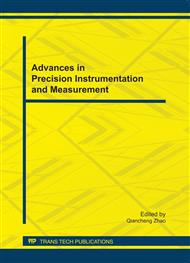[1]
Manabu HASHIMOTO and Kazuhiko SUMI: 3-D Object Recognition Based on Integration of Range Image and Gray-scale Image, Proceedings of The British Machine Vision Conference 2001, pp.253-262, (2001).
DOI: 10.5244/c.15.27
Google Scholar
[2]
Jamie SHOTTON, Andrew FITZGIBBON, Mat COOK, Toby SHARP, Mark FINOCCHIO, Richard MOORE, Alex KIPMAN, and Andrew BLAKE : Real-Time Human Pose Recognition in Parts from Single Depth Images, Proceedings of Computer Vision and Pattern Recognition 2011, (2011).
DOI: 10.1109/cvpr.2011.5995316
Google Scholar
[3]
Hiroshi KIMURA, Tomoyuki HORIUCHI, and Katsushi IKEUCHI: Human Robot Cooperation for Mechanical Assembly using Cooperative Vision System, 2nd Int. Workshop on Cooperative Distributed Vision, pp.213-228, (1998).
Google Scholar
[4]
Yue LIU, Yuhki KITAZONO, Shota NAKASHIMA, Lifeng ZHANG, and Seiichi SERIKAWA : Proposal of Driver Symbol Mark Detection using One-Dimensional Histogram Figure Extraction Method, Applied Mechanics and Materials (Trans Tech Publications), Vol. 36, pp.376-380, (2010).
DOI: 10.4028/www.scientific.net/amm.36.376
Google Scholar
[5]
Shota NAKASHIMA, Makoto MIYAUCHI, and Seiichi SERIKAWA: Proposal of a method to extract of arbitrary figures using one-dimensional histogram, Journal of Advanced Computational Intelligence and Intelligent Informatics, Vol. 13, No. 4, pp.380-385, (2009).
DOI: 10.1109/iccas.2008.4694232
Google Scholar
[6]
Shota NAKASHIMA and Seiichi SERIKAWA: Proposal of a method to extract straight line and circle using one-dimensional histogram, Journal of Artificial Life and Robotics, Vol. 13, No. 1, pp.306-310, (2008).
DOI: 10.1007/s10015-008-0582-9
Google Scholar
[7]
Yoshihiro OKADA: 3D Model Matching Based On Silhouette Image Matching, Proceedings of Circuits/Systems, Computers and Communications 2002, WSEAS Press, pp.380-385, (2002).
Google Scholar
[8]
Louis-Philippe MORENCY, Ali RAHIMI, and Trevor DARRELL: Fast 3D Model Acquisition from Stereo Images, Proceedings of 3D Processing • Visualization • Transmission, pp.172-176, (2002).
DOI: 10.1109/tdpvt.2002.1024057
Google Scholar
[9]
Lijing BU and Zhengpeng ZHANG: APPLICATION OF POINT CLOUDS FROM TERRESTRIAL 3D LASER SCANNER FOR DEFORMATION MEASUREMENTS, Proceedings of International Society for Photogrammetry and Remote Sensing, Vol. XXXVII, Part B5, pp.545-548, (2008).
Google Scholar
[10]
Andrew SCHWORER and Peter HOVEY: Newton-Raphson Versus Fisher Scoring Algorithms in Calculating Maximum Likelihood Estimates, Proceedings of Undergraduate Mathematics Day, (2004).
Google Scholar
[11]
Haruhiko OKUMURA, An algorithm encyclopedia using C, Gijutsu-Hyohron Co., p.262, (2006).
Google Scholar
[12]
W. H. Press, B. P. Flannery, S. A. Teulolsky, and W. T. Vetterling, Numerical Recipes-The Art of Scientific Computing, Cambridge University Press, pp.289-293, (1987).
DOI: 10.1016/s0003-2670(00)82860-3
Google Scholar


